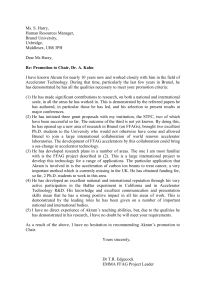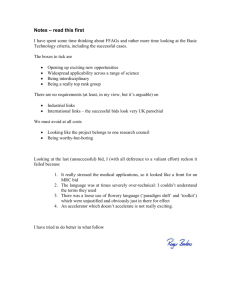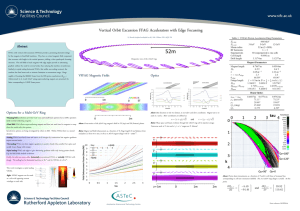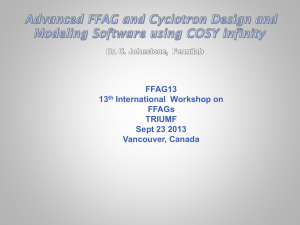C. Johnstone Fermilab/Particle Accelerator Corporation 2 Workshop on Hadron Therapy
advertisement
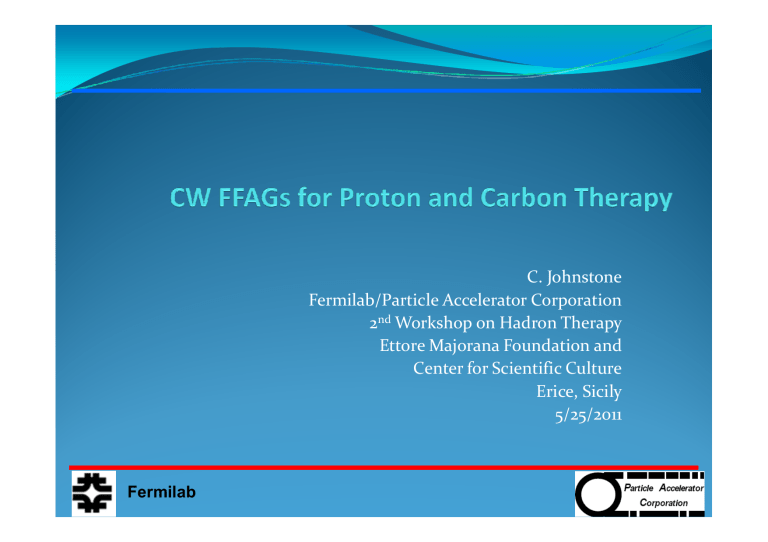
C. Johnstone Fermilab/Particle Accelerator Corporation 2nd Workshop on Hadron Therapy Ettore Majorana Foundation and Center for Scientific Culture Erice, Sicily 5/25/2011 Fermilab The International FFAG Collaboration: International Accelerator Laboratories and Universities U.S. Fermilab Brookhaven National Lab Lawrence Berkeley National Laboratory University of California: L.A., Riverside Michigan State University Illinois Institute of Technology Canada TRIUMF University of British Columbia Switzerland CERN France LPS U.K. Daresbury Laboratory. Manchester, Liverpool, Leeds, and Lancaster and Oxford University Imperial College Rutherford Appleton Laboratory John Adams Institute, Oxford Birmingham University Clatterbridge Centre for Oncology Beatson Oncology Centre Gray Cancer Center Japan KEK Kyoto University (KURRI) Osaka University Particle Accelerator Corporation Particle Accelerator Corporation Particle Accelerator Corp Accelerator and component design – FFAGs and synchrotrons, magnets, diagnostics Employees and collaborators Fred Mills (retired, Fermilab, built the first MURA FFAGs) C. Johnstone (Fermilab Richard Ford (Fermilab) V. Kashikhin (Fermilab) Shane Koscielniak (TRIUMF) Martin Berz (Michigan State University) Kyoko Makino (Michigan State University) Pavel Snopok (University of California, Riverside) Quick Field Guide to Fixed-Fielding Alternating Gradient FFAGs Simplest Dynamical Definition: FFAG is ~ a cyclotron with a gradient; beam confinement is via: Strong alternating-gradient (AG) focusing, both planes: radial sector FFAG normal/reversed gradients alternate (like a synchrotron) Gradient focusing in horizontal, edge focusing in vertical: spiral sector FFAG vertical envelope control is through edge focusing (like a cyclotron) the normal gradient increases edge focusing with radius /momentum (unlike a cyclotron) A cyclotron can be considered a class of FFAGs Types of FFAGs: Scaling: B field follows a scaling law as a function of radius - ∝rk (k a constant;) presentday scaling FFAGs: Y. Mori, Kyoto University Research Reactor Institute Nonscaling: Linear (quadrupole) gradient; beam parameters generally vary significantly with energy (EMMA FFAG, Daresbury Laboratory, first nonscaling FFAG) Nonlinear-gradient; beam parameters such as machine tune can be fixed (as in a synchrotron, PAMELA and a new generation of constant-tune, CW FFAGs) Why a FFAG – the reason is not mysterious? • The FFAG combines all forms of transverse beam (envelope) confinement in an arbitrary CF magnet: – For the horizontal, the three terms (in the thin lens approximation) are synchrotron 1/ f F = kF l + cyclotron ϑ η + ρF ρF with ϑ is the sector bend angle, η the edge angle (tangent is approximated), length, l , is the F half - magnet length and k F is the " local" gradient for an arbitrary order field. – For the vertical only the quadrupole gradient, kDl, and the edge term are available – In a FFAG the focusing terms can be varied independently optimizing machine parameters; i.e. footprint, aperture, and tune in a FFAG To summarize beam envelope control (in the thin Lens Limit): 1. Centripetal (Cyclotrons + FFAGs) : bend plane only, horizontally defocusing or focusing Strength ∝ θ/ρ (bend angle/bend radius of dipole field component on reference orbit) 2. Edge focusing (Cyclotrons + FFAGs) : Horizontally focusing / vertically defocusing, vice versa, or no focusing depending on field at entrance and entrance angle Strength ∝ tan η/ρ , (or ~ η/ρ for reasonably small edge-crossing angles) 3. Gradient focusing (Synchrotrons + FFAGs) : Body gradient, fields components > dipole: B= a + bx +cx2 + dx3 + … B’= b + 2cx + 3dx2 + … Linear field expansion, constant gradient Synchrotrons + linear-field nonscaling FFAGs (EMMA!, muon accelerators) Nonlinear field expansion up to order k, magnitude of gradient increases with r or energy: Scaling FFAGs Arbitrary nonlinear field expansion, magnitude of gradient increases with r or energy: Nonlinear Non-scaling FFAGs Edge crossing angles are kept deliberately small in large multi-cell synchrotron rings. This term becomes increasingly important for and causes problems in small synchrotron rings. More on the role of the gradient in edge-focusing Understanding the powerful interplay between gradient and edge focusing is critical to understanding the potential of FFAGs In cyclotrons, horizontal envelope control is through the centripetal term Centripetal term increases with radius/pathlength/momentum in the cyclotron magnets Vertical envelope control is through edge focusing / field shaping at the magnet edges proportional to the constant dipole field; more difficult to increase, much weaker than horizontal focusing in cyclotrons In FFAGs, the gradient increases both the horizontal (centripetal) and vertical (edge focusing) with radius/momentum This last point is very important for FFAGs because it allows the field, orbit location, and important machine parameters such as tune to be more independent and strongly controlled than in cyclotrons FFAGs and their Variations Scaling FFAGs (spiral or radialsector) are characterized by geometrically similar orbits of increasing radius, imposing a constant tune (field and derivative gradient scale identically with r). Magnetic field follows the law B ∝ rk, with r as the radius, and k as the constant field index. Spiral Sector: example: more compact; positive bend field only. Vertical focusing controlled by edge crossing angle. Field expansion: k determines multipole order; Comments: the lower the k value, the more slowly field increases with r and the larger the horizontal aperture, but the more linear the field composition and dynamics. F Radial Sector: example: This is a triplet DFD cell; there are also FDF, FODO and doublets. In a radial sector the D is the negative of the F field profile, but shorter. Linear nonscaling FFAGs for rapid acceleration Linear-field, nonscaling FFAGs. Ultra-compact magnet aperture, proposed and developed for High Energy Physics (Neutrino Factories and Muon Colliders), relaxes optical parameters and aims only for stable acceleration. In general they are not suitable for an accelerator with a modest acceleration system and accelerate only over a factor of 23 range in momentum. EMMA – world’s first nonscaling FFAG, @Daresbury Laboratory, NOW ACCELERATING BEAM !!!!! Extraction reference orbit D Injection reference orbit Cartoon of orbit compaction: nonsimilar orbits, nonconstant tune, resonance crossing Characteristics– tune sweep/unit cell, parabolic pathlength on momentum (small radial apertures); serpentine (rapid) acceleration – beam “phase-slips”, crossing the peak 3 times, accelerating between rf buckets Tune-stable nonscaling FFAGs 1) for slow acceleration Tune-stable, nonscaling FFAGs •Tune is strongest indicator of stable particle motion – allowing particles execute periodic motion eventually returning to the same transverse position relative to a reference orbit. Constraining the tune can be sufficient to design a stable machine. •Release of other linear optical parameter allows flexibility and optimization both in cost and complexity of the accelerator design; i.e. simpler magnets, strong vertical focusing, for example •Tune Stable Nonscaling FFAGs have either linear or nonlinear field profiles and/or edge contours Two lattice approaches Machida version - which uses a scaling law truncated at decapole, rectangular magnets , (not discussed here, see PAMELA project) and 2) Johnstone version – The most general form of a radial sector : allowing independent, unconstrained field and edge profiles between two combined-function magnets. 1 40c m ~17 cm Extraction orbit reference 2 Injection orbit reference 1st consideration for a “new” type of IBT Bringing the Community a Step Forward By combining attributes of the synchrotron and cyclotron the FFAG has the following combined advantages: The simplicity of fixed magnetic fields rather than pulsed operation Increased duty cycle over the synchrotron (50 Hz to 1 kHz RF swept-frequency cycling) Potential for variable energy extraction Elimination of degraders or substantial reduction in energy degradation Kicker or resonant extraction (Yokoi, PAMELA project) Cyclotron-like extraction - field shaping on extraction orbit Strong focusing allows synchrotron-like straights Lower losses associated with synchrotrons especially at extraction Goal: lower operational overhead and system simplicity of the cyclotron Are these Advantages Sufficient to Warrant a NEW type of Ion Beam Therapy Facility? Given the technical advances on conventional accelerator facilities I would say the answer is “NO” One of the strongest arguments for the prevailing dominance of cyclotrons is continuous (CW) beam. One paper which makes this specific case is: “Fast Scanning Techniques for Cancer Therapy with Hadrons – A Domain of Cyclotrons” J.M. Schippers, D. Meer, E. Pedroni, Proceedings of CYCLOTRONS 2010, Lanzhou, China The Conclusion: “In order to exploit the advantages of 3D pencil beam scanning, the scanning process must be performed as fast as possible. This allows different strategies to prevent dose errors due to tumour/organ motion. A reliable application of fast 3D scanning necessitates firm specifications on the accelerator: a CW beam, with an intensity that must be stable, quickly and accurately adjustable over a large dynamic range as well as a fast and accurate energy modulation. Currently the combination of these specifications is not possible to achieve with pulsed machine operation at repetition rates below 0.5-1 kHz.” One can employ broad band, (~MHz) RF, to attain these repetition rates (PAMELA) BUT --- this is a power-consumptive, often lossy solution with low acceleration capability and not fully realized at this time. Recent Innovation: Isochronous (CW) NS FFAGs - Cyclotron limit ~ 1 GeV protons P (MeV/c) or Bfield An isochronous orbits must be proportional to velocity Orbital path length at a given momentum follows the B field; therefore the B field must also scale with velocity At relativistic energies, momentum is an increasingly nonlinear function of velocity; therefore B field transitions from a linear slope to nonlinear, nonrelativistic to relativistic. THIS HAS BEEN ACHIEVED IN RECENT NONLINEAR NS FFAG DESIGNS Arbitrary nonlinear field expansion+edge angle can also constrain the tune The nonlinear gradient provides increased focusing at high energy in both planes, relative to the cyclotron 3500 FFAG limit 3000 ≥2 GeV protons 2500 2000 1500 1000 500 0 0,5 1 β or normalized pathlength 0 1,5 Innovations in Nonlinear, NS FFAG designs Isochronous (CW) FFAG designs have been successfully designed and will be presented later in this talk. Competitive BUT NOT COMPELLING What more can an FFAG offer? Dual Accelerator Patient Model (PSI data*) Below is a model-based treatment using 70 MeV as the lower limit since many nozzles ( or energy degraders) only work in the 70 to 250 MeV range. (Lower energies can be obtained by plastic range shifters placed close to the skin and aperture, for example with breast, pediatric patients, and parotid tumors in the jaw. ) Site Percentage Energy Range (MeV) Lung 9% 70 - 170 Breast 3% 70 - 140 CNS 15% 70 - 150 ( central nervous system, i.e., base of skull & tumors around spinal vertebrae) Rectum 2% 70- 170 ( also cervical cancers may be a few % in this energy range) Pediatric 8% 70 - 150 Head & Neck 15% 70 - 150 Prostate 45% 200-250 Other 2% This fits nicely with a dual energy accelerator system where E≤150 MeV can be used for roughly 50% of the patients. At PSI all patients were treated with E< 180 MeV excluding prostates. * *based on discussions with G. Coutrakon, 2009. Two-Stage Proton Therapy Facility Dual Accelerator Model: Simultaneous treatment/setup can be conveniently split into 70-150 MeV, 150-250 MeV Accelerator is a small part of the cost of a facility Delivery beamlines are also a drop in the bucket Could consider separate gantries: gantries with smaller energy range requirements are conceivably cheaper – easier magnets; lower energy gantry much smaller. Dual accelerators are facilitated using FFAGs by Multiple long straights Ease of injection/extraction CW operation in both stages CW 18-150 MeV H- (p + 2e) NS FFAG Stripping wire Htreatment beam proton for a low energy nv 3.0 n h, n v 0.5 2.5 0.4 2.0 0.3 1.5 0.2 1.0 0.1 cA 4.5 cB A 200 4.0 B 350 400 450 500 550 P, @MeV êcD 200 250 300 350 400 450 500 550 P, @MeV êcD cC Tune per cell and ring tune. Extended fringe field will split tunes cD E 2.5 2.0 300 C 3.5 3.0 250 D F G cF H cG cH 0.5 1.0 1.5 2.0 2.5 3.0 cE DRad Ravg 4.5 250 300 350 400 450 500 550 P, @MeV êcD 4.0 -0.01 3.5 3.0 -0.02 2.5 -0.03 2.0 200 Comments and further work 250 300 350 400 450 500 550 P, @MeV êcD -0.04 Average radius vs momentum and deviation in % from isochronous average radius Peak field 0.8T @extraction in F - can take this design to 180 MeV Increase compactness: 3-sector or no reverse bends, low losses – reduced shielding Extraction at 150 MeV through field shaping of high-energy orbit Particle Accelerator Corporation CW 150-250 MeV SC Proton Ring 0,02 (Riso-Ravg) /Riso nv 3.0 0,015 2.5 2.0 cA 2.4 2.2 2.0 1.8 1.6 cB A cC B F C cD G D cE cF H cG cH 0.2 0.4 0.6 0.8 1.0 1.2 1.4 E 0,005 1.5 1.0 0,01 Deviation from isochronicity 0 Ring tune 600 650 1,6 1,55 1,5 1,45 700 550 P, @MeV êcD 600 650 700 750 Momentum MeV/c Ravg (blue) and Risochronous (red) 1,4 1,35 1,3 1,25 1,2 Comments and further work 550 600 650 Peak field 3.5T @extraction in F; small 25 cm aperture Low losses Kicker or resonant extraction CW extraction through field shaping (as in a cyclotron) + degrader 700 750 Particle Accelerator Corporation Summary of Operational Advantages in a Dual Stage FFAG Proton Therapy Facility CW operation with …. Variable energy Limited use of degraders if needed; 250 – 150; or 150 – 70 MeV. Low loss operation, comparable to synchrotrons Multi- accelerators/multi-room operation is perhaps the most important next step in patient throughput. Less susceptible to hysteresis, smaller tuning window Less susceptible to energy variations in beam phase space Amenable to most advanced hardware developments in cyclotrons and synchrotrons Much of the ground-breaking work in PAMELA can be adapted (the higher energy ring, for example uses up to octupole field expansion) Research Facility : Funding for Proton Therapy In the U.S. non-private funding for medical facilities is essentially NonExistent . Funding tends to be confined to R&D not “publicly offered” for routine service Medical is particularly difficult One caveat is university-based facilities, Generally do not have the resources to fund large scale, “experimental” facility No strictly “Local Competence” centers based on government funding Requires a broader R&D justification –~1 GeV CW proton beam is required by Accelerator Driven Subcritical Reacter (ADS): Homeland Security (cargo inspection) A 1.2 GeV proton machine can be used for 400 MeV/u C6+ Basis for a Research and Possible Competence Facility in the U.S. Advanced design and simulation of an Isochronous 250-1000 MeV Nonscaling FFAG 2m nv 3.0 DRad 0.07 2.5 0.06 cA A 5.0 4.5 2.5 1.5 C 3.5 3.0 0.04 cC B 4.0 E 0.05 2.0 cB 0.03 cD D F G cF H cG cH 0.5 1.0 1.5 2.0 2.5 3.0 3.5 0.02 1.0 cE 0.01 800 1000 1200 1400 1600 P, @MeV êcD 1000 1200 1400 1600 P, @MeV êcD Ravg 5.0 General Parameters of an initial 0. 250 – 1 GeV non-scaling, nearisochronous FFAG lattice design Parameter Avg. Radius (m) 250 MeV 3.419 585 MeV 4.307 1000 MeV 5.030 Cell ν x / νy (2π rad) 0.380/0.237 1.520/0.948 1.62/-0.14 1.17/0.38 0.400/0.149 1.600/0.596 0.383/0.242 1.532/0.968 2.06/-0.31 2.35/-0.42 1.59/0.79 1.94/1.14 Ring. Field F/D (T) Magnet Size F/D Inj • 4.5 4.0 1000 1200 1400 1600 P, @MeV êcD Clockwise: Matematica: Ring tune, deviation from isochronous orbit (%), and radius vs. momentum Comments and further work – – Tracking results indicate ~50-100π mm-mr; relatively insensitive to errors Low losses Particle Accelerator Corporation Advanced Modeling: Simulations in COSY INFINITY In general conventional accelerator* codes provide too-little flexibility in field description and are limited to low order in the dynamics, new tools were developed for the study and analysis of FFAG dynamics based on transfer map techniques unique to the code COSY INFINITY. HARD EDGE Various methods of describing complex fields and components are now supported including representation in radius-dependent Fourier modes, complex magnet edge contours, as well as the capability to interject calculated or measured field data from a magnet design code or actual components. FULL FRINGE FIELDS Arbitrary shapes, field content, contours Other FFAG codes: ZGOUBI, F. Meot, some implementation in CYCLOPS (Baartman, TRIUMF) Particle Accelerator Corporation Example of dynamics studies of fixed-field accelerators using new tools in COSY Below is a sample FFAG having sixfold symmetry, with focusing stemming from an azimuthal field variation expressed as a single Fourier mode as well as edge focusing. The system is studied to various orders of out-of-plane expansion with the results for orders three and five shown below (typical of a conventional out-of-plane expansion in codes like Cyclops). Tracking in a model non-scaling six-fold symmetric FFAG for horizontal (left pairs) and vertical (right, pairs) with 3rd (top), 5th(middle), and 11th-order (bottom) out of plane expansion, with focusing from an azimuthal field variation expressed as a single Fourier mode as well as edge focusing . With (left) and without (right) Expo symplectification is shown. Field Map and Tracking: 250-1000 MeV Isochronous Proton FFAG: COSY INFINITY: Order 11 Immediate large DA aperture: +/- 0.25 m horizontal Larger than vertical gap of magnet 50-100 mm-mr without correction 0.1-1% error tolerance –typical magnet tolerances Final isochronous optimization will be performed using advanced optimizers in COSY Dynamic aperture at 250, 585, and1000 MeV – step size is 1.5 cm in the horizontal (left) and 1 mm in the vertical (right). 1-GeV Proton Driver Modeled in CYCLOPS: fine mesh and fringe fields (Y.N Ray and M. Craddock, TRIUMF) B field with Enge function fall off tune per cell (radial, horizontal) tune/cell (z, vertical) frequency change, isochronous to +/- 3% using simple hard-edge model: progress will require the advanced codes; agrees with COSY results Recent ZGOUBI Results S. Sheehy: DA even larger Very Preliminary Hardware Concepts for a SC Nonlinear NS FFAG (ADS application) • An innovative new approach to a combined-function 4T magnet is under design based conventional NbTi superconducting magnet technology and construction techniques. Preliminary rf parameters have been investigated With a small vertical aperture of only a few cm, the large horizontal magnet apertures do not present a serious technical issue in terms of an rf structure. In Summary – Case for Carbon FFAGs can reach the highest energies in CW mode (lower energy injection would likely be via C4+ or 5+ ). Carbon requires a synchrocyclotron Small (~1/2 the footprint of 60 m circumference synchrotron) 12 magnets in four periods, i.e. four 2m straights – can be expanded to 3-4 m. Injection, extraction, RF, one spare straight Multi-ion capability: charge/mass ratio of ½ is supported (He, H2+) Can use the preceding ring designs as injectors – staged proton/carbon facility with multi-port treatment capability Variable energy is still possible or minimal use of degrader Avoids the fragmentation problem of carbon with a cyclotron/full degrader Delivers a low, constant dose: easy to monitor and integrate CW sets the stage for PBS using carbon Fulfills and presents the strongest argument for pursuing a new IBT facility – satisfying Development, Operation, Research and potentially Local Competence – particularly since carbon facilities are still in a development stage. Nesting Rings for Compact Footprint Embedded rings support a compact multi-ion therapy facility. 3.5 m 12C 6+ p Development of New Scaling FFAGs and NS FFAGs: EMMA Revival of the FFAG is completely due to Y. Mori, presently at Kyoto University – scaling FFAGs Does the NS FFAG work? Very long list of detractors Short list of advanced designers – most of whom have moved into this field – many are in the auditorium Most important supporter: A. Sessler ~2002 proposed building an electron model of a NS FFAG The U.K. collaboration took the lead (Daresbury Laboratory, AsTeC, Oxford, U of Manchester, and many others) submitted a NEST proposal and EMMA and PAMELA projects were “born” circa 2004 S. Berg, BNL did the final doublet lattice S. Koscielniak, TRIUMF, first predicted the existence of the serpentine acceleration channel – acceleration between fixed rf buckets Operating Scaling FFAGs or Scaling FFAGs under construction (not updated) - clearly not an experimental machine Ion E (MeV) Cells Spiral Angle Radius (m) First Beam Technical Details KEK-PoP p 1 8 0º 0.8-1.1 2000 KEK p 150 12 0º 4.5-5.2 2003 100 Hz, 90% ext. KURRI -ADSR (Figure 1) p 2.5 8 40º 0.6-1.0 2006 Initial spec: 120 Hz, 1µA Now: 1kHz, 100µA, @200 MeV p 20 8 0º 1.4-1.7 2006 p 150 12 0º 4.5-5.1 (2007) NEDO-ERIT p 11 8 0º 2.35 (2008) 70mA ionization cooling ring PRISM study α 0.8 6 0º 3.3 (2008) Phase space rotator Radiatron e 5 12 0º 0.3-0.7 (2008) 24 kW, 10 kHz, betatron acc. FFAGs in Industry Mitsubishi – hand-held 1 MeV electron accelerator (spiral sector FFAG) NHV Corporation Developing several commercial electron FFAGs to replace Rhodotron, for example Number of proton FFAG designs have been completed for medical use (RACCAM, PAMELA projects) Passport Systems : compact electron FFAGs for security applications Radiabeam – compact electron FFAG development Last Word: EMMA – Does the NS FFAG work? The definitive answer is YES ! PREDICTION VS MEASURED! Measured orbital period in the EMMA ring as a function of momentum, measured cell tune based on BPM data, and measured phase space trajectories of beams starting from 12.0 MeV/c equivalent momentum with 5 different initial phases and accelerated to more than 18 MeV/c equivalent momentum. At each empty circle, the phase is measured in the 23rd cell and measured BPM orbit position. Nesting Rings for Compact Applications FFAG designs are advancing rapidly internationally, particularly for medical and high-energy applications with an isochronous nonscaling FFAG now designed and verified The first demonstration of Accelerator Driven Subcritical Reactor was performed this year at KURRI using the FFAG. Embedded rings supporting a compact multi-ion therapy facility are an exciting new direction for FFAGs. Highly advanced design and simulation tools have been developed and tested for FFAGs and cyclotrons and are ready for public distribution 12C 6+ 3.5 m p Periodic Beam Transport combined emittance/ESS collimation Vertical half-ring, 360 deg phase advance Achromat Dispersion wave peaks in mid-straights Geometric emittance + energy selection 4.4 4.2 4.0 3.8 3.6 3.4 3.2 3.0 cA EA cE cB cC n h, n v 0.5 0.4 0.3 FB 0.2 cD C G 0.0 690 HD cF 0.1 700 710 720 730 P, @MeV êcD 90 deg cells: achromatic across large energy range cG cH 0.5 1.0 1.5 Particle Accelerator Corporation Example: 50 keV to 9 MeV Compact Electron Accelerator nv 3.0 2.5 2.0 1.5 1.0 2 4 6 8 P, @MeV êcD COMPARISON Tune Results: hard edge vs. extendedfFringe field Mathematica® Full 9-MeV ring with injection and extraction orbits displayed. TOSCA Magnet Design and Field profiles. COSY INFINITY Tune Results COSY Results: Electron Ring COSY results and tracking at 3 energies: 50 keV, 4.4 MeV, and 9 MeV machine. Except for the tune change required at horizontal injection, the DA is very large.
